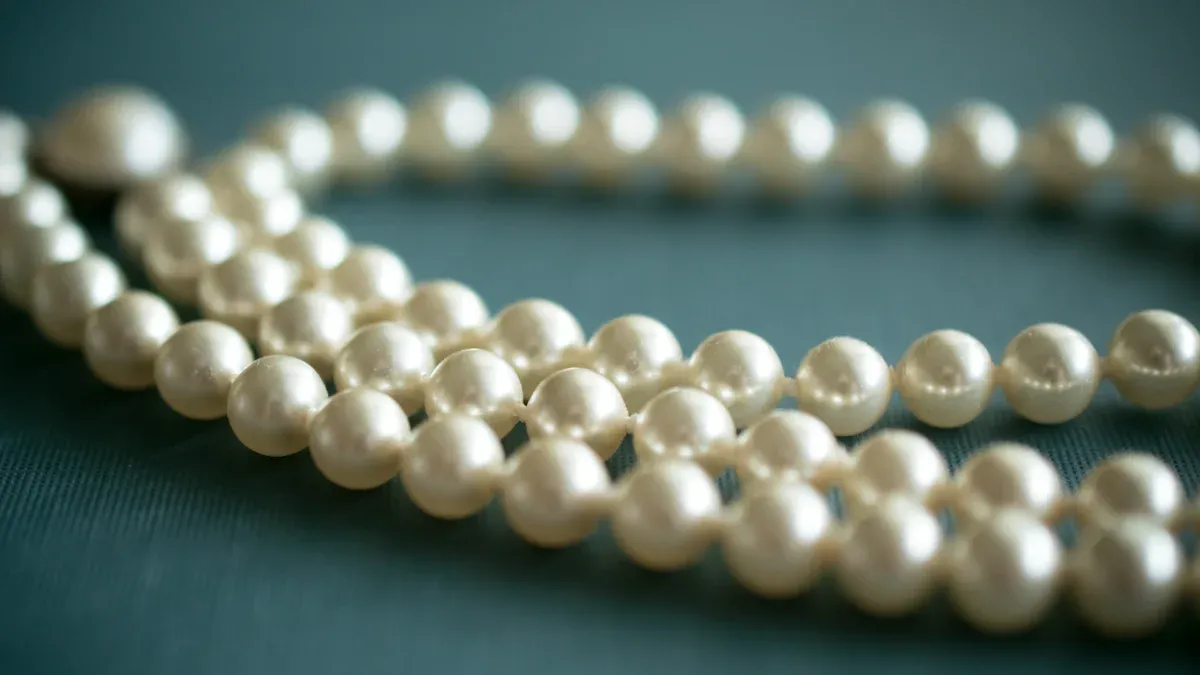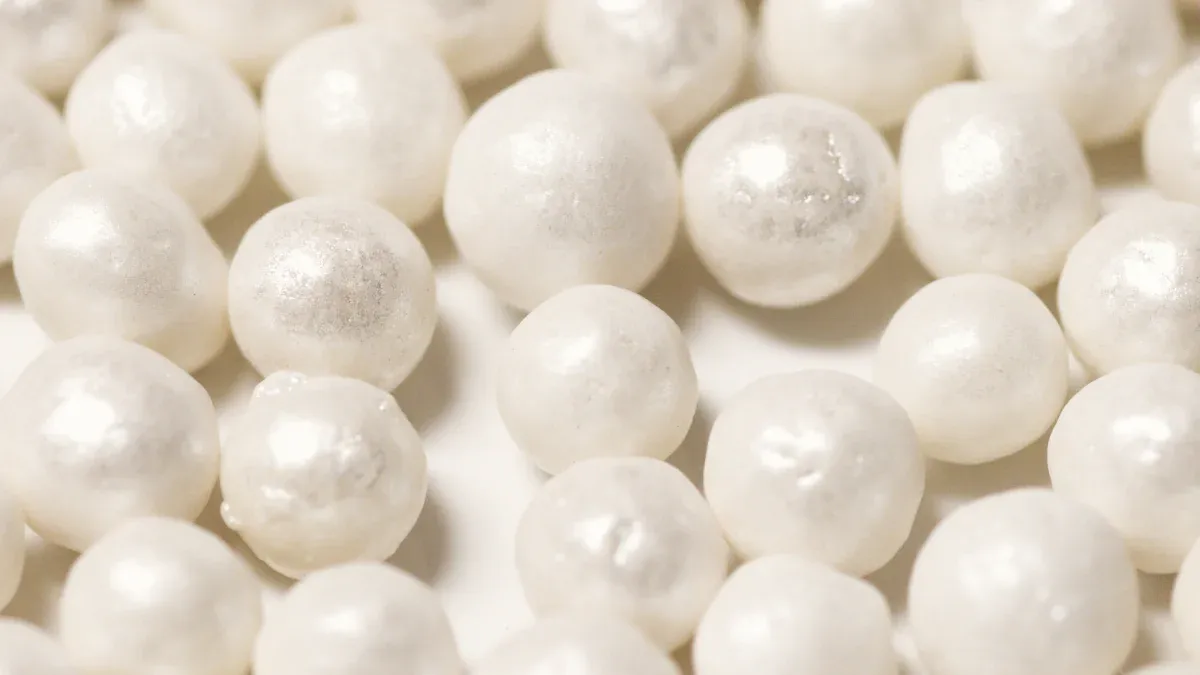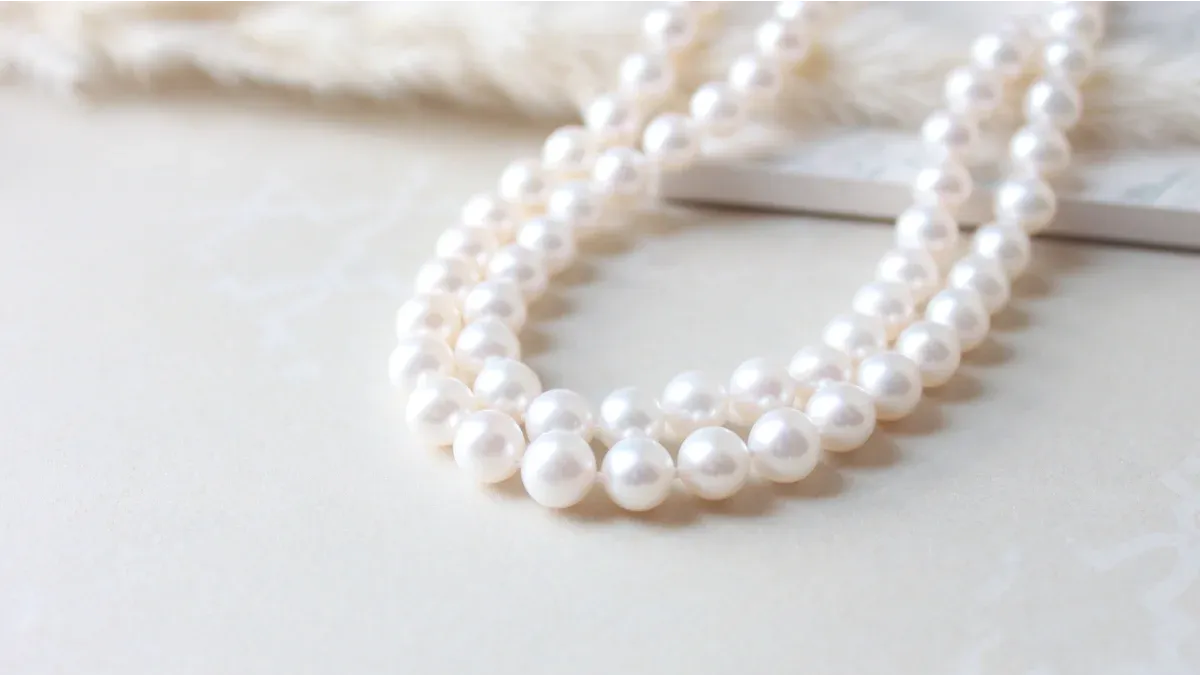
People notice pearl necklaces because they look nice and are worth a lot. The world’s pearl jewelry market was about $13.53 billion in 2024. It might grow to $48.14 billion by 2034. When you look at a pearl necklace, check seven main grading factors. These are size, shape, color, luster, surface quality, nacre quality, and matching. Each factor, especially luster and surface quality, affects the pearl’s value. Knowing these things helps you not make expensive mistakes.
Key Takeaways
-
Luster is the most important thing for pearl value. Always pick pearls that shine a lot for the best quality.
-
Surface quality is important too. Pick pearls with smooth surfaces for more value and beauty.
-
Size and shape also affect value. Bigger and round pearls are worth more, but special shapes can look nice too.
-
Color is also important. Rare colors like blue or black pearls are very wanted.
-
Matching is very important for necklaces. Make sure all pearls in a strand look the same in size, shape, and color for a nice look.
Pearl Necklace Grading

When you look at a pearl necklace, you need to know what makes it special. The seven main factors help you understand the grading and value of pearls. These are the same factors that experts use in pearl grading systems. Each one affects how much a pearl necklace is worth and how beautiful it looks.
Luster
Luster is the most important of all the pearl value factors. You can see luster when light reflects off the surface of pearls. High luster means the pearls look bright and shiny. Low luster makes pearls look dull. Luster is graded from Poor to Excellent. Pearls with excellent luster show sharp, bright reflections. This makes them more valuable and beautiful. Luster is the essence of a pearl and has the biggest effect on its value. If you want the best pearl necklace, always look for pearls with high luster.
Tip: Hold the pearls under a light. If you see clear, bright reflections, the luster is high.
Surface Quality
Surface quality is another key factor in pearl grading. Pearls with clean surfaces have higher value. If you see marks like pin-pricks, chalky spots, or wrinkles, the value goes down. Most pearls have some natural marks, but the fewer, the better. The best pearls are at least 95% free of defects. You can use this table to understand how surface quality affects value:
|
Surface Characteristic |
Impact on Value |
|---|---|
|
Clean surfaces |
Higher value |
|
Inclusions (pin-pricks, scoring marks, chalky spots, wrinkles) |
Lower value |
|
Unique marks from natural formation |
Common occurrence, affects value |
Shape
Shape is one of the most noticeable pearl value factors. Round pearls are the most classic and valuable. They are rare, which makes them expensive. Perfectly round pearls are hard to find, so they cost more. Other shapes, like oval or baroque, are still beautiful but usually less expensive. Some people like baroque pearls for their unique look. When you choose a pearl necklace, round pearls will give you the highest value.
Size
Size is easy to see and measure. Larger pearls are more valuable than smaller ones. When pearls grow bigger, they become rarer. This makes size a major pearl value factor. Most necklaces use pearls between 6mm and 8mm, but pearls over 10mm are very special. If you want a necklace that stands out, look for larger pearls.
Color
Color is one of the most interesting pearl value factors. Pearls come in many colors, like white, black, pink, blue, and lavender. Some colors, such as naturally colored blue, black, and lavender, are rare and highly prized. The body color and overtone (the hint of color you see on the surface) both matter. Pearls with unique body colors and complex overtones have higher value. Cultured pearls from Akoya, South Sea, and Tahitian oysters often show these rare colors. Natural color is always more valuable than treated color.
Matching
Matching is important when you look at a pearl necklace. All pearls in the necklace should look similar in size, shape, and color. Good matching makes the necklace look balanced and beautiful. Poor matching lowers the value. Experts check matching as one of the main pearl value factors. If you want a necklace that looks perfect, make sure the pearls match well.
-
Matching involves:
-
Size
-
Shape
-
Color
-
Matching is essential for the overall look and value of the necklace.
Nacre Quality
Nacre quality is the last of the gia 7 pearl value factors. Nacre is the layer that forms the pearl. Thick nacre means the pearl is strong and has deep luster. Thin nacre can make pearls look dull and weak. Cultured pearls with thick nacre last longer and keep their beauty. Always check nacre quality when you buy a pearl necklace. Thick nacre is a sign of high value and good quality.
Note: The best pearls have thick nacre, high luster, clean surfaces, round shape, and large size. These are the top pearl value factors in any pearl grading system.
Pearl Value Factors

Type of Pearl
The type of pearl changes how much it costs. Each kind has special features and value. South Sea, Tahitian, Akoya, and Freshwater pearls are the main types in necklaces. Every type is different in the pearl classification system. Look at the table below to compare prices and see how type affects value:
|
Pearl Type |
Characteristics |
Value Influence |
|---|---|---|
|
South Sea Pearls |
Largest, thick nacre, soft luster, colors range from silvery white to deep golden |
Highly valuable, especially golden variants due to rarity |
|
Tahitian Pearls |
Naturally dark, colors include charcoal black, green, peacock, silver, eggplant |
Highly desirable, especially in larger sizes or matched strands |
|
Akoya Pearls |
Perfectly round, brilliant luster, classic white pearls |
Prized for high-end jewelry, associated with elegance |
|
Freshwater Pearls |
Affordable, wide range of shapes and colors, often pastel |
Most versatile and affordable, modern techniques yield high-luster options |
When picking a pearl necklace, check the type first. South Sea and Tahitian pearls usually cost more. Akoya pearls look classic and fancy. Freshwater pearls have more choices and lower prices.
Origin
Where pearls come from matters for their value. Pearls from places like Australia or French Polynesia are worth more. The pearl classification system uses origin to show if pearls are rare or real. Always ask about where pearls are from before buying. Pearls from trusted places are better and keep their price.
Brand and Certification
A famous brand and certification make pearls worth more. Top brands use strict grading and give certificates. These papers prove pearls are real and good quality. Look for necklaces with certificates from gem experts. This helps protect your money and makes sure you get real pearls.
-
Certificates and papers make expensive pearl necklaces worth more.
-
Certified gem experts grade pearls differently than other gems.
Buying from a good brand with certificates is a smart choice.
Craftsmanship
How pearls are made changes how they look and cost. Skilled jewelers match pearls by size, shape, and color. They use strong strings and safe clasps. Good craftsmanship makes necklaces last longer and look nicer. Check the details of the necklace. Well-made necklaces keep their value over time.
Market Trends
Market trends change what pearls cost and how many people want them. Today, simple and pretty designs are popular. Many people want classic necklaces or special pieces for their family. New ways to grow pearls make cultured pearls better. Things like inflation also change prices. People in Asia, North America, Europe, and the Middle East like different styles. As economies get better, buyers want good value and real pearls. Brands with high-quality pearls and fair prices get more buyers.
Tip: Watch for new styles and what people want. This can help you pick pearls that keep their value.
Value of Natural Pearls
Natural pearls are very special and rare. They grow in the wild without help from people. Natural pearls have unique shapes and colors. Because they are hard to find, they cost much more than cultured pearls. Museums and collectors want these pearls. If you own a natural pearl necklace, you have something historic. Natural pearls are valuable because they are beautiful, rare, and have a story.
How Much Are Pearls Worth
You might ask, how much do pearls cost? The price depends on type, quality, origin, and market trends. Use the table below to compare prices for each type:
|
Pearl Type |
Price Range (Strand) |
|---|---|
|
South Sea |
$1,000 – $100,000+ |
|
Tahitian |
$500 – $25,000+ |
|
Akoya |
$300 – $10,000+ |
|
Freshwater |
$50 – $2,000+ |
|
Natural (Wild) |
$500 – $2,000,000+ |
Pearl necklace prices can be very different. Pearls with thick nacre, bright luster, and clean surfaces cost more. Natural pearls have the highest prices. Cultured pearls come in many prices, so most people can buy them. Always check quality and certificates before buying. This helps you make a smart choice when buying pearl jewelry.
Assessing Pearl Necklaces
Visual Inspection
You can learn a lot about pearls by looking at them closely. Start with a luster check. Hold the pearls under a light. Real pearls show a bright, deep shine. Fake pearls look chalky or too shiny, almost like plastic. Next, try the tooth test. Gently rub a pearl against your teeth. Real pearls feel gritty. Fake pearls feel smooth. You can also rub two pearls together. Real pearls make a fine powder. Fakes do not. For another test, drop a pearl from a short height. Real pearls bounce. Fakes usually do not move much. These steps help you spot real pearls and check their quality.
-
Luster check: Look for a deep, sharp shine.
-
Tooth test: Feel for a gritty texture.
-
Rubbing test: Rub two pearls and look for powder.
-
Drop test: See if the pearl bounces.
Tip: Always inspect pearls in good light. This helps you see their true color and luster.
Questions for Sellers
When you buy pearls, ask the seller key questions. This helps you understand the value and quality of the pearls. Here are some questions you should ask:
-
Where did these pearls come from?
-
Are these pearls natural or cultured?
-
What type of pearls are in this necklace?
-
How thick is the nacre on these pearls?
-
Do you have a grading report or certificate for these pearls?
-
Have these pearls been treated or dyed?
These questions help you learn about the pearls’ origin, type, and quality. Sellers who answer clearly show they know the value of their pearls.
Grading Reports
Grading reports give you important details about pearls. You may see two types of documents: a certificate of pearl identification and a pearl grading report. The certificate tells you if the pearls are natural or cultured. It lists the product name, size, and an image. The grading report gives a full review of the pearls’ quality. It covers luster, surface, shape, size, color, and matching.
|
Feature |
Certificate of Pearl Identification |
Pearl Grading Report |
|---|---|---|
|
Purpose |
Shows if pearls are natural/cultured |
Rates the quality of the pearls |
|
Information |
Name, size, image |
Full grading and quality details |
|
Content |
Simple |
Detailed and complete |
Some grading reports use special terms. For example, "peacock color range" means the pearls have a rare color. "Hanadama quality range" shows the pearls meet high standards. Always read these reports to know the true value and quality of the pearls you want to buy.
Pearl Grading Myths
Common Misconceptions
Lots of people believe things about pearls that are not true. Some think every pearl has a perfect surface. Only the best pearls look almost perfect. Most pearls have tiny marks or spots. Some buyers believe bigger pearls are always better. Size does not always mean better quality. Pearls come in different types. Each type uses its own grading system. This can make comparing pearls confusing. Every kind of pearl has special grading rules. You should not expect all pearls to follow the same standards.
|
Misconception |
Explanation |
|---|---|
|
All pearls have perfect surfaces |
Only the best pearls look almost perfect; most have small marks. |
|
Larger pearls are always of higher quality |
Bigger pearls do not always mean better quality; grading is different for each type. |
|
Different grading systems exist |
Each kind of pearl uses its own grading system, which can confuse buyers. |
|
Different types of pearls have the same grading |
Every type of pearl has special grading rules, so buyers can get mixed up. |
Overlooked Value Factors
When you look at pearls, you might only notice size or color. Many buyers forget other things that matter. Luster shows how much light shines from pearls. Surface quality means how smooth and clean pearls look. Shape, color, nacre quality, and matching also change value. If you ignore these, you might miss great pearls. Matching is important for necklaces. Pearls should look alike in size, color, and shape. Nacre quality helps pearls last longer and keeps them shiny. Some buyers think size is most important, but luster and surface quality matter more.
|
Value Factor |
Description |
|---|---|
|
Luster |
The shine and how much light pearls reflect. |
|
Surface Quality |
How smooth and clean the pearl’s surface is. |
|
Size |
How big the pearl is, which can change value. |
|
Shape |
The way the pearl looks, like round or baroque. |
|
Color |
The color of the pearl, which can make it more wanted. |
|
Nacre Quality |
How thick and good the nacre is, which helps pearls last and shine. |
|
Matching |
How much pearls look alike in a necklace or jewelry. |
Tip: Do not let different grading systems confuse you. Always check each value factor to find the best pearls.
Buyer Mistakes
You can stop yourself from making mistakes when buying pearls. Some buyers think all pearls are the same. Every type of pearl has its own special qualities and value. Many people see pearls only as fashion items. Pearls can be good investments if you pick high-quality ones. Always check the necklace size for comfort and style. Not caring for pearls can hurt them and lower their value. Buying pearls just because they are trendy may not be smart. You should think about where you will wear the necklace. Some necklaces are best for fancy events, while others are good for everyday.
-
Thinking all pearls are the same and missing what makes each type special.
-
Seeing pearls only as accessories and not as possible investments.
-
Forgetting to check necklace size for comfort and style.
-
Not taking care of pearls, which can damage them and lower their value.
-
Buying pearls just because they are trendy, which may not last.
-
Not thinking about if the necklace fits the occasion.
Remember: If you know what matters, you can pick pearls that stay beautiful and valuable.
When you choose pearls, remember the main grading criteria and value factors. These include:
-
Luster: Pearls shine best with high luster.
-
Shape: Round pearls are rare, but unique shapes are popular.
-
Color: Pearls show many colors, and creamy rose is special.
-
Surface: Clean pearls have higher value.
-
Nacre Thickness: Thick nacre means better pearl quality.
-
Size: Larger pearls increase in value.
-
Matching: Pearls in a strand should look the same.
Understanding pearl classification helps you avoid mistakes. You can spot pearls with true value and not overpay. If you feel unsure, ask an expert. Pearl classification systems can be confusing, and pearls from different sellers may use different grading. Expert advice helps you get the right pearls for your needs. When you know about pearl classification, you can buy pearls with confidence and enjoy their beauty for years.
Tip: Knowledge of pearl classification and grading helps you choose pearls that keep their value and appeal.
FAQ
How do you tell if a pearl is real or fake?
You can rub a pearl gently against your teeth. Real pearls feel gritty. Fake pearls feel smooth. You can also check the luster. Real pearls shine with a deep glow.
What makes one pearl necklace more expensive than another?
Pearl necklaces cost more when pearls have high luster, thick nacre, clean surfaces, and round shapes. Rare types like South Sea or natural pearls also raise the price.
Can you wear pearl necklaces every day?
You can wear pearls daily, but you should avoid water, sweat, and perfume. Wipe pearls with a soft cloth after wearing. Store them in a soft pouch to keep them safe.
Do pearls lose value over time?
Pearls keep their value if you care for them. Clean them gently and store them away from sunlight. Pearls with thick nacre and high luster stay beautiful for many years.
What is the best way to clean a pearl necklace?
Use a soft, damp cloth to wipe each pearl. Do not use soap or chemicals. Let the necklace dry before storing. This keeps pearls shiny and safe.





